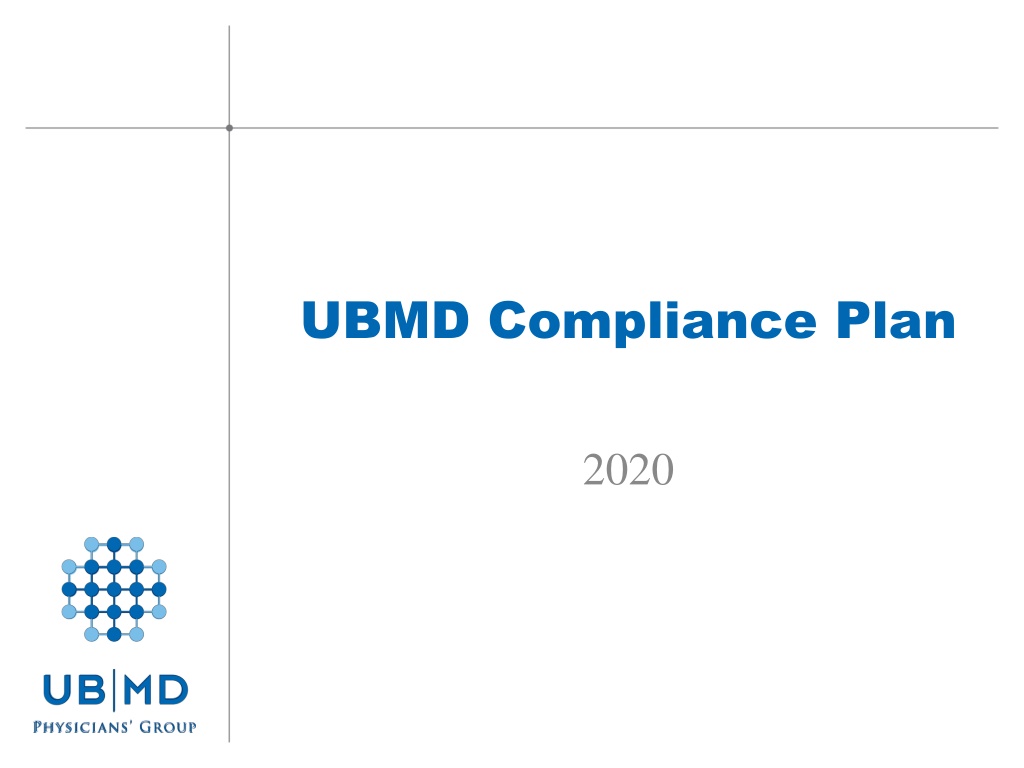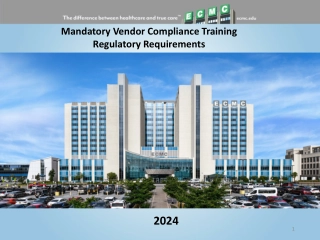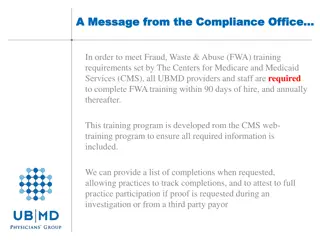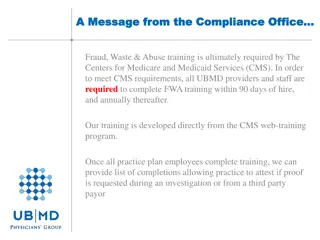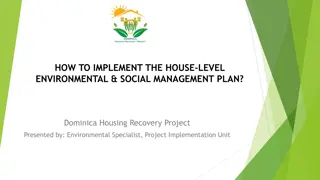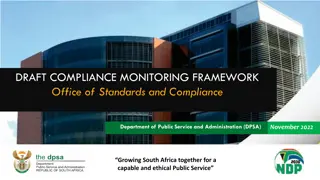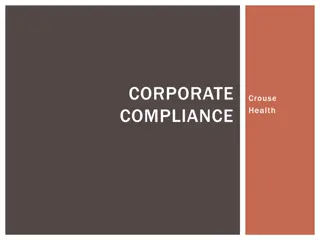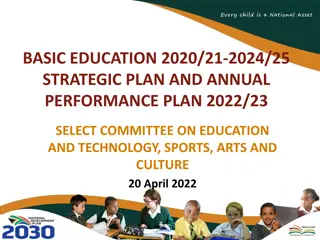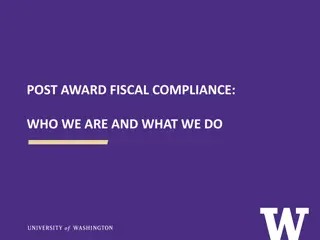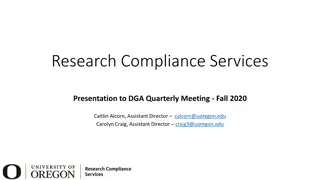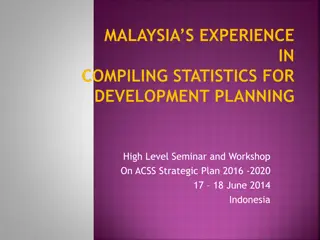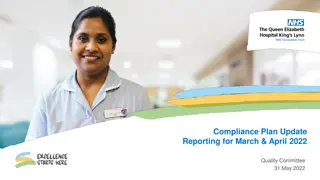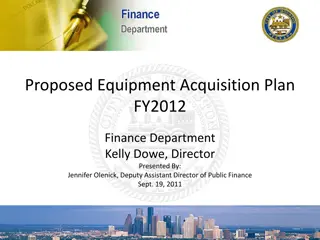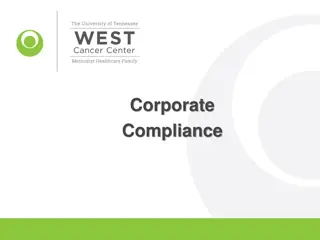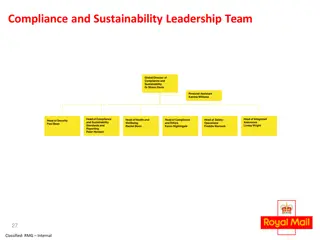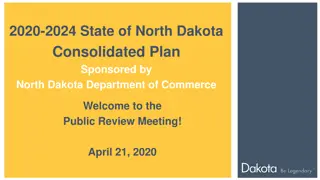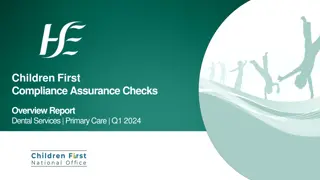UBMD Compliance Plan 2020 Overview
This document outlines the UBMD Compliance Plan 2020, detailing the introduction, affiliated practice corporations, elements of an effective compliance plan, code of conduct, policies, summary of laws and regulations, revisions, training programs for employees, internal monitoring and auditing procedures, communication channels, enforcement of disciplinary standards, responding to violations, and non-retaliation policies. The plan emphasizes the importance of compliance in all aspects of UBMD operations and sets forth guidelines for maintaining a compliant organizational culture.
Download Presentation

Please find below an Image/Link to download the presentation.
The content on the website is provided AS IS for your information and personal use only. It may not be sold, licensed, or shared on other websites without obtaining consent from the author.If you encounter any issues during the download, it is possible that the publisher has removed the file from their server.
You are allowed to download the files provided on this website for personal or commercial use, subject to the condition that they are used lawfully. All files are the property of their respective owners.
The content on the website is provided AS IS for your information and personal use only. It may not be sold, licensed, or shared on other websites without obtaining consent from the author.
E N D
Presentation Transcript
UBMD Compliance Plan 2020
Parts of the Compliance Plan I. Introduction II. UBMD Affiliated Practice Corporations & Compliance Office Staff III. Elements of an Effective Compliance Plan IV. Code of Conduct V. Policies VI. Summary of Pertinent Laws, Rules & Regulations VII. Revisions to the Compliance Plan Attachments
8 Elements of an Effective Compliance Plan 1. Code of Conduct and Written Policies and Procedures Establish compliance standards Describe compliance expectations Implement the operation of the compliance program Provide guidance to employees on dealing with compliance issues Identify how to communicate compliance issues to appropriate personnel Describe how potential compliance problems are investigated & resolved. Designated Compliance Officer Vested with responsibility of day-to-day operation of compliance program Reports periodically to the UBMD Executive Committee & FPMP Governing Board Training & Education All UBMD employees, including executives & governing body members, shall be trained in compliance issues, expectations & compliance program operation. Training shall occur annually, and as part of orientation for all new employees. 2. 3.
8 Elements of an Effective Compliance Plan 4. Internal Monitoring & Auditing As system of internal and, if necessary, external audits shall be in place for routine identification of compliance risk areas & for self-evaluation of such risk areas, and for evaluation of potential or actual non-compliance as a result of such self-evaluations and audits. Risk assessments and audits are conducted on a regular basis. Communications Communication lines to the compliance officer shall be in place & accessible to all employees, executives & governing body members to allow compliance issues to be reported. Communication lines shall include a method for anonymous & confidential good faith reporting of know or potential compliance issues. Enforcement of Disciplinary Standards The Code of Conduct and Policies within this Compliance Plan have been established to ensure UBMD employees are aware that compliance shall be treated seriously, and that violations and non-compliance shall be dealt with fairly, consistently and uniformly. 5. 6.
8 Elements of an Effective Compliance Plan 7. Responding to Detected Violations Reasonable and prompt steps shall be taken to respond to all violations detected through audits and monitoring, and those that are reported by individuals. Implementation of a corrective action plan shall take place for any violations confirmed by an investigation. Non-retaliation Retaliation for reporting compliance concerns in good faith will not be tolerated regardless of whether or not a violation is found as a result of the initial report. Reports of retaliation shall be investigated thoroughly, and can result in disciplinary action up to and including termination of employment. 8.
Code of Conduct The Code of Conduct is a statement of UBMD s dedication to upholding the ethical, professional and legal standards we use as a basis for our daily and long term decisions and actions. Compliance with Laws, Regulations, Policies & Procedures Relationships with Other Providers Claims with Third Party Payers Confidential Information Conflict of Interest Business Information & Relationships Violations
Business Information & Business Information & Relationships Relationships 1. Acceptance of Business Courtesies Employees may not solicit or accept gifts or gratuities from individuals or business organizations. 2. Competitor Information Gather competitor information through legal an ethical means only. 3. Contract Negotiation All data gathered during contract negotiations must be accurate, current & complete. No contracts will be entered into with any person or company convicted of a criminal offense related to health care and/or is listed as debarred, excluded or ineligible by a federal agency.
Violations Violations Confirmed violations of this Code of Conduct will result in appropriate disciplinary action against the offending individual(s), up to and including termination from employment.
Policies Policies A. B. C. D. E. F. G. H. I. J. K. L. M. Non-Retaliation/Whistleblowers N. Internal Investigations O. Corrective Action P. Appeals Q. Government Investigations Education & Training Coding & Documentation Electronic Medical Records Record Retention Audit & Monitoring Overpayments Monitoring Exclusionary Databases Reporting Misconduct Diversity Language Access Services Harassment Sexual Harassment
Policy On: Policy On: Education & Training Education & Training
Education & Training Education & Training Mandatory New Hire Training Within six months of commencement of employment within UBMD, all new employees must attend a one-hour compliance orientation and training session with the UBMD Compliance Officer or his/her designee. Failure of a new employee to attend this session may result in disciplinary action up to and including termination of employment. Mandatory Annual Training All UBMD employees are required to complete annual compliance training to include HIPAA; Fraud, Waste & Abuse, and Diversity. All UBMD providers and employees are required to complete two (2) hours of compliance training biennially (every two years). Other Educational Services Quarterly Newsletter Compliance Website Personalized Service
Policy On : Policy On : Coding & Coding & Documentation Documentation
All medical records generated by UBMD physicians must All medical records generated by UBMD physicians must be complete, legible and include the following elements: be complete, legible and include the following elements: Reason for encounter Relevant patient history Physical examination findings Prior diagnostic test results Assessment, clinical impression or diagnosis Plan for care Date and legible identity of the observer Statement of rationale for ordering diagnostic tests and other ancillary services, if not documented and easily inferred by a third party reviewer with appropriate medical training Past and present diagnoses accessible to the treating and/or consulting physician Identification of appropriate health risk factors Statements of patient s progress, response to and changes in treatment, and revision of diagnosis Addendums to the medical record should be dated the day the information is added to the record and not for the date the service was provided
CPT and ICD CPT and ICD- -10 10- -CM Codes CM Codes Reported on all reimbursement claim forms or billing statements should be adequately supported by the documentation in the medical record, and be submitted only in the name of the provider who performed the service.
Path Requirements Path Requirements Payment for teaching physicians provided in teaching settings using physician fee schedule is permissible only if: Services are personally provided by physician, not resident; Teaching physician is physically present during key portions of the services that resident performs; Teaching physician provides care under conditions outlined in Part V, Section B-1 of this Compliance Plan. For purposes of payment, E/M services billed by the teaching physician require that they personally document at least the following: Review of resident s note; Confirm or edit of resident s findings; Document performance or participation in key components; Summarize participation in the management of the patient; and Date, time, and signature on note.
Path Requirements Path Requirements Examples of correct wording: I performed a history and physical examination of the patient and discussed his management with the resident. I reviewed the resident s note and agree with the documented findings and plan of care. See resident s note for details. I saw and evaluated the patient and agree with the resident s note for details. I saw and evaluated the patient and agree with the resident s findings and plans as written. Examples of unacceptable documentation: Agree with above. Rounded, reviewed, agreed. Discussed with resident. Agree. Patient seen and evaluated. Primary Care Exception A graduate medical education program that has been granted a primary care exception may bill Medicare for lower and mid-level E/M services provided by residents.
Student Documentation Student Documentation Student Documentation of E/M Services Students may document services in the medical record. The teaching physician must verify in the medical record all student documentation or findings, including history, physical exam, and/or medical decision making. The teaching physician must personally perform (or re-perform) the physical exam and medical decision making activities of the E/M service being billed, but may verify any student documentation of them in the medical record, rather than re-documenting this work. To ensure that we compliantly bill for these services, the following Student Attestation must be added and signed by the supervising physician: I have seen, personally examined and assessed the patient to establish a plan of care. I have reviewed the medical record and verify that all student documentation or findings, including history, physical exam and/or medical decision making are accurate. I have performed or re- performed, the physical exam and medical decision making activities to the extent they were conducted by a student.
Non Non- -Physician Practitioners Physician Practitioners Incident-to services are billed under the M.D., paid at 100% of the M.D. fee schedule. Private office, outpatient only. No hospital outpatients, inpatients, emergency department patients. Follow-up/established patients only. No new patients. Requires direct supervision by physician. Direct supervision means the doctor must be present in the office suite, immediately available to provide service if needed. NPP documents service in medical record; M.D. does not need to sign. Direct billing is billed under the NPP, paid at 85% of the M.D. fee schedule. Not site-restricted; may be inpatient, outpatient, office, hospital, etc. New or follow-up/established patient. Requires general supervision by M.D. General supervision includes the attending physician s overall direction and control of the training and equipment, but the physician s presence is not required during the diagnostic procedure. The physician does not have to be present when the service is performed.
Non Non- -Physician Practitioners Physician Practitioners Shared billing applies when NPP and M. D. are members of the same group, and the combined service is billed either under the NPP s or M.D. s number. Not site-restricted; may be inpatient, outpatient, office, hospital, etc. E/M services only. No critical care, no SNG, no procedures, no consults. M.S. must provide face-to-face portion of E/M encounter. If incident-to requirements are not met, then must bill under the NPP s number. Local health insurers have adopted this as their incident-to policy. Medicare has a separate policy that should be followed for Medicare patients.
Scribes Scribes Residents, interns & fellows may NOT act as scribes. Ancillary providers (NPs, PAs, MAs, RNs) & other staff MAY serve as scribes. Medical students MAY act as scribes recording the actions & words in real time. They must not be seeing the patient in any clinical capacity, and may not interject their own observations or impressions. Do not confuse this ability to scribe with the medical student s ability to individually document information for a billable service. Anyone acting as a scribe must receive appropriate compliance & computer training, review the UBMD scribe policy & sign the Scribe Agreement (Attachment B). A scribed note must accurately reflect the services provided for any given date of services. The billing provider is responsible for the content of the scribed note. A scribed note can be hand-written and scanned or typed/created directly in the EMR. A Scribe Agreement should be completed by anyone acting as a scribe.
Policy On : Policy On : Electronic Electronic Medical Records Medical Records
The Medical Record The Medical Record The record should contain sufficient information to: Identify the patient; Support the Diagnosis(es); Justify treatment and facilitate the continuity of patient care. Providers are prohibited from allowing others to use their password or sign their notes. The record should clearly identify author & date of all entries. Providers are responsible for citing & summarizing applicable lab data, pathology and radiology reports rather than copy such reports in their entirety in the notes. Providers are responsible for correcting any errors identified within their own document, via a dated amendment if note is already signed. Providers are required to document in compliance with all federal, state & local laws, as well as UBMD policy.
The Medical Record The Medical Record Further requirements pertaining to copying and pasting progress notes: Copied information must be reconfirmed and revised as necessary to accurately reflect the specific date of service. It is not advisable to duplicate information that does not specifically impact a specific date of service. Copying of subjective data (i.e. history of present illness and plan of care) is strongly discouraged. Copying teaching physician attestations from previous notes is prohibited. Information that is copied should not exceed six (6) months from the date of the original note. Information copied forward from the providers original notes should be closely examined for accuracy, completeness and relevance. Documentation must reference the date of the original note. Example: Copied from my previous note dated
Templates Templates Providers may choose any template to assist in documenting medical information. CMS discourages the use of templates which provide limited options such as check boxes or predefined answers, and/or limited space to enter information, or those designed to gather selected information focused primarily for reimbursement purposes as they often fail to capture sufficient detailed clinical information to demonstrate that all coverage and coding requirements are met, or adequately show that medical necessity criteria for the service are met. If using a template, UBMD providers are advised to select one that allows for a full and complete collection of information to demonstrate that the applicable coverage and coding criteria, as well as medical necessity, are met.
Cloning Cloning Documentation is considered cloned when it is worded exactly like, or similar to, previous entries. Documentation must reflect the patient condition necessitating treatment, the treatment rendered and, if applicable, the overall progress of the patient to demonstrate medical necessity. Cloning can also occur when the documentation is exactly the same from patient to patient. Individualized patient notes for each patient encounter are required.
EHR Audits EHR Audits Electronic Health Records should be audited at the practice plan level by each practice plan on a quarterly basis as follows: Review records of VIP patients to make sure records were accessed only by those who took part in the care and treatment of the patient. Review records of UBMD employees who are also practice plan patients to make sure records were accessed only by those who took part in the care and treatment of the patient. Randomly select up to five (5) practice plan employees, and check one day from the previous quarter to make sure their access to records were appropriate. Any employee found to be inappropriately accessing the E HR of a patient will face disciplinary action up to and including termination.
Policy On : Policy On : Record Retention Record Retention
Record Retention Record Retention The following record retention guidelines shall be followed by all UBMD employees For adults, clinical records must be maintained for a minimum of seven (7) years from the last contact with the patient. For minors and obstetrics, clinical records must be maintained through the age of twenty-one (21) of the child, or seven (7) years from the last date of service, whichever is longer. Patient billing records must be maintained for seven (7) years. This includes maintenance of superbills, inpatient/outpatient/surgery charge cards, cash and credit card payment logs and copies of checks. Paper superbills that are added electronically do not need to be maintained. For deceased patients, clinical records must be maintained a minimum of 6 years after death. The record s retention requirement should be measured from the date of the last professional contact with the patient to determine the length of time the record is required to be retained. An electronic scan of the entire paper record will meet the retention requirement, provided the technology to access the record is maintained for the applicable period of time. In the event a patient files a lawsuit against UBMD, records should be maintained until the lawsuit is resolved. Under the False Claims Act, claims may be brought up to six (6) years after the incident; however, on occasion, the time has been extended to ten (10) years.
Policy On : Policy On : Audit & Monitoring Audit & Monitoring
Objectives & Types Objectives & Types The objectives of UBMD s accuracy monitoring are: To ensure accurate, complete and legible documentation of medical services provided To ensure proper coding and billing based on the documentation, and; To determine whether or not any problem areas exist in documentation, coding or billing; and if so, to focus on improving those areas with the physician. There are several types of audits that may be performed, including: Periodic Audits Investigational Audits Parallel Audits Requested Audits
Periodic Audits Periodic Audits The internal auditor for each Practice Plan will be responsible for annually reviewing the lesser of 2% of each provider s submitted claims, or 10 claims, unless a more stringent requirement is otherwise specified in the individual Practice Plan compliance policies. If a provider s charts are found to be less than 85% compliant, the internal auditor will conduct an individual educational session and perform a follow-up audit within six weeks to evaluate the effectiveness of the education. Provider then receives a second, problem-focused audit. Failure to improve compliance percentages may result in corrective action. A minimum of ten (10) records will be reviewed annually per full- time provider. Audit reports shall be submitted on a form acceptable to the UBMD Director of Audit & Education once per year, as scheduled by the UBMD Director of Audit & Education.
Periodic Audits Periodic Audits Audit results will contain information such as number of encounters reviewed, the number of compliant and noncompliant records, review codes for noncompliance, and follow-up activities for tracking and educational purposes. A plan of correction should be reported for all deficiencies identified. Additional records may be reviewed at the discretion of the UBMD Compliance Officer. Periodic and follow-up audits will be conducted by auditors retained by the individual practice plans. Periodic audits are independent and impartial chart reviews. They shall remain separate from the coding function within the Practice Plan. Auditors shall not be the same person who codes the medical records.
Investigational Audits Investigational Audits Conducted by an internal auditor, UBMD s Compliance Officer, or his/her designee. Conducted in response to issues or concerns that might arise within a Practice Plan either by an employee or an outside source. The auditor will consult with the Compliance Officer or his/her designee and the Practice Plan President prior to conducting an unscheduled audit.
Parallel & Requested Audits Parallel & Requested Audits Parallel Audits May beconducted any time an outside agency such as the U.S. Attorney s Office, U.S. Department of Justice or the New York State Attorney General s Office initiates an investigation of a UBMD provider or Practice Plan. Intended to provide the UBMD Compliance Officer with information that may be helpful in defending or settling any charges that may arise from the outside investigation. Requested Audits Audits may be conducted at the request of the Compliance Officer at any time to ensure compliance with third party billing requirements and/or applicable fraud and abuse laws.
Policy On : Policy On : Overpayments Overpayments
Overpayments Overpayments Failure to report and return an overpayment can result in potential penalties including false claims liability, civil monetary penalties and exclusion from federal health care programs. Must be reported only if a person identifies the overpayment within six years of the date that the overpayment was received. The six year look-back period will apply to any overpayments reported or repaid on or after March 13, 2016. Any information or a potential overpayment shall be promptly evaluated for credibility, documented and followed up on accordingly. All Practice Plan providers and their staff are to use reasonable diligence to identify, report and repay any overpayments using applicable claims adjustment, credit balance, self-reported refund, or other appropriate process established by the applicable Medicare contractor to satisfy the obligation to report and return overpayments.
Policy On : Policy On : Monitoring Monitoring Exclusionary Exclusionary Databases Databases
Monitoring Exclusionary Monitoring Exclusionary Databases Databases The following Exclusionary Databases must be checked monthly: OIG-LEIE (US Office of Inspector General s List of Excluded Individuals & Entities) GSA-SAM (US General Services Administration s System for Award Management; formerly known as Excluded Parties List System) OMIG List (NYS Office of the Medicaid Inspector General List of Restricted & Excluded Providers) The following Exclusionary Databases must be checked against providers only when a provider is credentialed or re-credentialed: SDN List (US Treasury s Office of Foreign Assets Control Specially Designated Nationals) NPPES (US Centers for Medicare & Medicaid Services National Plan & Provider Enumeration System) Death Master (US Social Security Death Master File)
Monitoring Exclusionary Monitoring Exclusionary Databases Databases If a match is found on any exclusionary database, the provider, staff member or agent/vendor should be immediately suspended. That person should be given the opportunity to appeal to the appropriate government agency to have his or her name removed from the Exclusionary Database or receive a waiver from the appropriate government agency. If those actions are not successful, provider or staff member must be terminated from employment and the contract with the agent/vendor must be terminated.
Policy On : Policy On : Reporting Misconduct Reporting Misconduct
Examples of Misconduct Examples of Misconduct Repeated instances of improper coding Inadequate medical record documentation Falsification or alteration of medical records Harassment, intimidation Threatening, vulgar or obscene behavior Acceptance of bribes or other kickbacks Unlawful attempts to induce referrals Retaliation against someone who has made a previous report concerning a compliance violation HIPAA violations
Procedure for Procedure for Reporting Misconduct Reporting Misconduct All reports of known or suspected misconduct may be made in any of the following ways: Report directly to Practice Plan President or Compliance Coordinator. Report to UBMD Compliance Officer via: Phone: 888-4705 Email: larryd@buffalo.edu Interoffice mail: Lawrence C. DiGiulio, 77 Goodell, Suite 310 U.S. Mail: Lawrence C. DiGiulio, 77 Goodell Street, Suite 310 Buffalo, New York, 14203 Call the Anonymous Compliance Hotline at 888-4752. Complete a Compliance Issue Reporting Form
Procedure for Procedure for Reporting Misconduct Reporting Misconduct All reports of misconduct should include pertinent information, including: The name of the individual and/or Practice Plan about which the report is being made; A factual and objective description of the questionable practice, including date and time; If involving inappropriate billing, any information available regarding if/when claim was billed, amount billed, whether payment was received, what steps if any were taken to stop payment or refund payment; Medical records involved, identified by either patient name or number; Any other information deemed necessary for investigation. Each report of misconduct will be followed up with an internal investigation. If warranted following complete investigation, corrective action may be imposed.
Hotline & Reporting Form Hotline & Reporting Form Compliance Hotline Hotline number: 888-4752 Accessible 24 hours, 7 days a week, allowing callers to leave a message no matter when they call. Calls monitored Monday-Friday 8:00am-5:00pm. A copy of the Compliance Hotline flier should be posted in all practice plan back-office areas, visible to employees. All calls to the hotline will be confidential, and no attempt will be made to determine the number or location of the caller. It is our policy to preserve anonymity of callers who wish to remain anonymous, subject to limits imposed by law. Compliance Issue Reporting Form Completed forms may be sent to the Compliance Office via email, fax, U.S. Mail, Interoffice Mail. Form allows the reporter to remain anonymous if desired.
Failure to Report Failure to Report Failure or refusal to report misconduct or fraudulent or illegal practices is a violation of this Compliance Plan and may result in disciplinary action, up to and including termination, of any individual who suspects misconduct but fails to report it.
Policy On : Policy On : Diversity Diversity
Diversity Diversity UBMD encourages and promotes diversity in its organization at all levels, and values individual and cultural differences within its workforce. UBMD prohibits any conduct of discrimination against employees, patients, residents, fellows, students or vendors with regard to race, color, religion, sex, national origin, age, disability, sexual orientation, marital status, pregnancy, military status, veteran status, or any other status or classification protected by federal, state or local law. Discrimination or harassment based on any protected status or classification will not be tolerated, and may result in disciplinary action up to and including termination.
Policy On : Policy On : Language Access Language Access Services Services
Language Access Services Language Access Services When necessary, each practice plan will provide interpretive services to Limited English Proficiency (LEP) and hearing impaired patients. Interpretive services will be provided by the practice plan through use of competent bilingual staff, staff interpreters, contracts or formal arrangements with local organizations providing interpretation or translation services, or technology and telephonic interpretive services. This assistance will be provided by the practice plan at no cost to the patient. Each practice plan will inform LEP and hearing impaired persons of the availability of interpretive services, free of charge, by providing written notice in languages LEP persons will understand. Notices and signs must be posted and provided in reception areas and other points of entry.
Policy On : Policy On : Social Media Social Media
